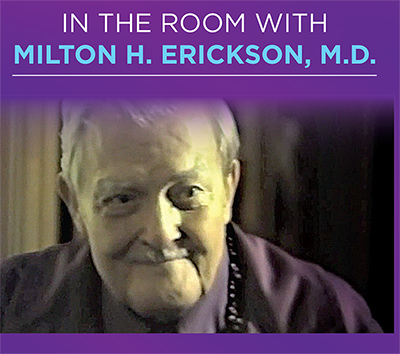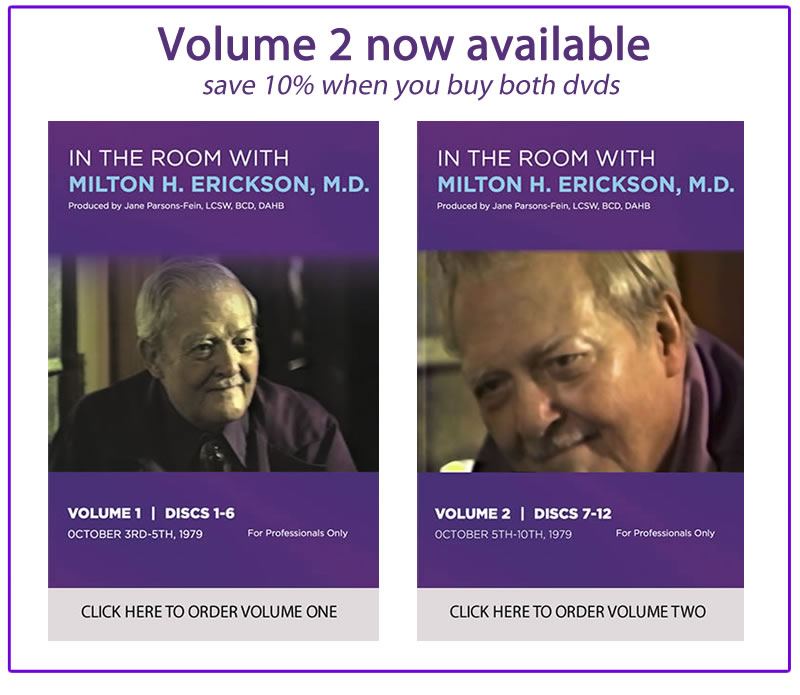About Milton Erickson DVDs and Transcripts
 This three-volume set of DVDs and Transcripts contains 35 hours of Dr. Erickson conducting his unique training sessions with a group of select students. The filming took place from October 3rd through October 12th, 1979, in the small room next to Erickson’s office in Phoenix, Arizona.
This three-volume set of DVDs and Transcripts contains 35 hours of Dr. Erickson conducting his unique training sessions with a group of select students. The filming took place from October 3rd through October 12th, 1979, in the small room next to Erickson’s office in Phoenix, Arizona.
Each volume shows Erickson discussing some of his most inspiring, brilliant, and original clinical interventions. He describes many case histories from his work that are not only examples of clinical creativity, but also metaphors for life. They are taught on many levels and warrant much re-viewing and study. They don’t teach us how to imitate Erickson, but how to be our natural selves and engage with our clients creatively and authentically.
Volume 2 is a continuation of Volume 1. Beyond that, it is difficult to compare and contrast these volumes. Erickson did not follow a preset linear outline in his teaching. The flow of his teaching seemed to spring from his own unconscious and also in response to the students’ presence. Every person in the group had unique reactions to various case stories that Erickson told. Some students would have dinner after the day’s training, and many would often say that they felt Erickson was addressing them personally when telling a particular case story.
ABOUT THE TRANSCRIPTS
These beautifully-bound hardcover books are verbatim transcripts of each volume in the series. The Table of Contents in each book is the same as the menu of stories on the DVDs for ease of reference. There is ample room on each page for notes. The Transcripts are a valuable resource for those who want to study Erickson’s language in depth and teach using the DVDs. These transcripts are available for everyone to purchase.
REFLECTIONS BY JANE PARSONS-FEIN
Here is why I think we should spend many hours watching Milton Erickson’s work over and over again. Every time I watch him I learn something new on some level and discover that it has woven itself into my own work in it’s own way.
It is true that Dr. Milton Erickson said, “Don’t imitate my voice, or my cadence. Just discover your own. Be your own natural self.” He also said, “Trust your unconscious; it knows more than you do.” I believe that in NLP (Neuro-linguistic Programming), “pacing”, “leading”, etc. are all linear descriptive techniques of how Erickson was able to “tune in to” the unconscious of his students/patients and join them. In teaching hypnosis, beginners can use scripts, but I believe that as students advance they let go of the scripts and communicate from their own unconscious so they are 100% focused and present with their subjects. Erickson said, “Anything you do consciously, you can do better in a trance state… highly-focused attention.”
Because I have been with these videos for many years, every time I watch them my experience has been different. My associations have changed and sometimes deepened, but to try to describe the levels and the changes is like trying to describe a piece of music in mere words. Repeated watching for many people has added dimensions to their associations and understandings which then emerge into their work.
There are short case histories and longer case histories in both volumes. There is individual work with a resistant student threaded throughout. Erickson said that the more resistant the patient the more indirect the metaphor. Over time as we sat in front of him listening to his cases, all of us had our own experience and we each put our own meanings on what he said and how he said it. Like a symphony conductor he interweaves the themes involving the whole orchestra. This process ran through his work with us every day.
Perhaps you may want to have a description of specific distinctions and differences between Volume 1 and Volume 2. I don’t want to narrow people’s perceptions by breaking it down in literal fashion. Even when you glance through the menus, you can see their variety, their depth, and their richness.
Going over the range of cases that he described affected us by the quality of his thinking about each patient he had and the care with which he shared his deepest experiences. His innovative understandings pervaded his storytelling. Because he himself was so comfortable with his unconscious and easily shifted from one state to another, his gentle humanity touched each of us.
Modeling excellence in someone else is only the first step. You then integrate it into your own unique essential self. As I have said, I think that Erickson’s ease with his own unconscious made it safe for people around him to open up parts of themselves hitherto unrecognized. I think the teaching of hypnotic techniques, for example, Neuro-linguistic Programming (NLP) become powerful in treatment when with practice, they are integrated into your own unconscious, in your own way in your own rhythm and in your own style. When you do that your patient can feel safe and trust you. As Erickson said that when you try to imitate someone else, “It’s a hollow pretense and the patient knows it.”
I hope this will be helpful to you and that you will continue to learn from him.
Jane
To Purchase the Transcripts only, Click Here
To purchase the DVD set or both the DVD set and the Transcripts, Click Here
If you would like a pdf advertisement of these DVD sets for your organization, please click here.
Jane Parsons-Fein
LCSW, BCD, DAHB has been teaching Ericksonian hypnosis and psychotherapy since 1981.
Her practice is located in New York City.
www.therapyandhypnosisny.com
copyright © 2018
Jane Parsons-Fein & Nick Parsons
ALL RIGHTS RESERVED
IN THE ROOM WITH MILTON H. ERICKSON, M.D.
